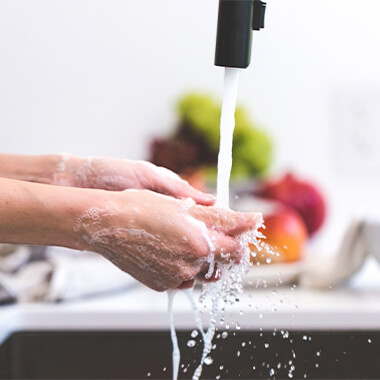Food Safety
NUTRITION SCIENCE REVIEW
Food Safety Practices

Picture from Pexels
These simple practices can keep patients safe while avoiding unnecessary restrictions.
Selected Sources & Further Reading
- American Cancer Society – “Food Safety During Cancer Treatment”
- Foster M. “Reevaluating the Neutropenic Diet: Time to Change,” CJON 2014, 18(2), 239-241.
- Memorial Sloan Kettering Cancer Center – “How People with Cancer Can Decrease Food Poisoning Risk”
- Sonbol MB et. al. “Neutropenic diets to prevent cancer infections: updated systematic review andmeta-analysis,” BMJ Supp Palliat Care.2019 Dec;9(4):425-433.
- Trifilio S. et. al. “Questioning the role of neutropenic diet following hematopoietic stem cell transplant,”Biol Blood Marrow Transplant 2012 Sep;18(9):1385-90.
- USDA – Food Safety: A Need-to-Know Guide for those at Risk
Food Safety
Many cancer patients are understandably concerned about avoiding infections, including foodborne infection. Cancer and many treatments can compromise the immune system, making it harder to fight off pathogens found in food. But where do we find a balance between caution and panic?
Historically, many cancer centers recommended a neutropenic diet for all actively treated patients. This diet eliminates some higher-risk foods, such as raw seafood and sprouts, as well as healthy foods like raw produce.
Meta-analyses have found no benefit to the neutropenic diet versus a regular diet. In fact, there is evidence that neutropenic diets may increase infection risk, potentially related to alterations to gut microbiota.
During cancer treatments, additional diet restrictions can create further obstacles to adequate intake at a time when patients may be experiencing changes to their appetite and tastes, as well as increase tension between patients and family members who fear eating the “wrong foods.”
Official recommendations have moved away from restrictions and toward education on safe food handling practices. These fall under four main categories: Clean, Separate, Cook, and Chill.
Clean
- Wash hands before and after handling food.
- Use disposable cloths to clean kitchen surfaces; or frequently change out cloth towels.
- Rinse fruits and vegetables with water, including those with skins or rinds that you will not eat.
Separate
- Avoid cross-contamination, which occurs when bacteria spreads from one food to another.
- Wash cutting boards, dishes, utensils, and counter tops between preparation of raw meats and food that will not be cooked. Consider separate cutting boards.
Cook
- Heat all foods to their minimum recommended internal temperature. Use a food thermometer for best accuracy.
- Seafood – 145°F
- Whole beef, lamb, pork, veal – 145°F
- Eggs, Ground Beef – 160°F
- Poultry, all Leftovers – 165°F
Chill
- Refrigerate or freeze meats, eggs, and dairy within 2 hours of purchase.
- Promptly refrigerate unused portions of meals.
- Thaw foods properly. The refrigerator is the safest option. If cold water or microwave methods are used, cook immediately. Never thaw at room temperature.
Published: May 1, 2023


Comments